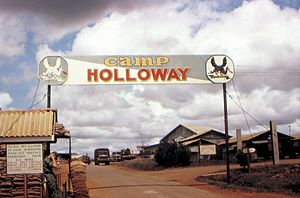
Back هجوم معسكر هولواي Arabic Attaque du camp Holloway French Attacco a Camp Holloway Italian Angrepet på Pleiku-flybasen NB Útok na základňu Holloway 7. februára 1965 Slovak Holloway Kampı saldırısı Turkish
| Attack on Camp Holloway | |||||||
|---|---|---|---|---|---|---|---|
| Part of Vietnam War | |||||||
 Camp Holloway was attacked by the Viet Cong on 7 February 1965, which led to the further escalation of the Vietnam War. | |||||||
| |||||||
| Belligerents | |||||||
|
|
| ||||||
| Commanders and leaders | |||||||
|
|
| ||||||
| Units involved | |||||||
|
|
| ||||||
| Strength | |||||||
| 300 | 400 | ||||||
| Casualties and losses | |||||||
| Probably 1[3] |
7 killed 104 wounded 10 aircraft destroyed 15 aircraft damaged | ||||||
The attack on Camp Holloway occurred during the early hours of February 7, 1965, in the early stages of the Vietnam War. Camp Holloway was a helicopter facility constructed by the United States Army near Pleiku in 1962. It was built to support the operations of Free World Military Forces in the Central Highlands of South Vietnam.
In August 1964, the United States Navy reported they were attacked by torpedo boats of the North Vietnamese Vietnam People's Navy in what became known as the Tonkin Gulf Incident. In response to the perceived aggression of Communist forces in Southeast Asia, the United States Congress passed the Tonkin Gulf Resolution which enabled U.S. President Lyndon B. Johnson to deploy conventional military forces in the region to prevent further attacks by the North Vietnamese. Immediately after the Tonkin Gulf Resolution was passed, Johnson ordered the bombing of North Vietnamese Navy bases in retaliation for the reported attacks on U.S. Navy warships between 2 and 4 August 1964. However, the Viet Cong (VC) forces in South Vietnam were not deterred by the threat of U.S. retaliation.
Throughout 1964, the VC launched several attacks on U.S. military facilities in South Vietnam but Johnson did not start further retaliations against North Vietnam, as he tried to avoid upsetting U.S. public opinion during the 1964 United States Presidential Election. The Soviet Union, on the other hand, were experiencing political changes of their own as Nikita Khrushchev was removed from power. As leader of the Soviet Union, Khrushchev had begun the process of disengagement from Vietnam by reducing economic and military aid to North Vietnam. However, in the aftermath of Khrushchev's downfall, the Soviet government had to redefine their role in Southeast Asia, particularly in Vietnam, to compete with the growing influence of the People's Republic of China.
In February 1965 Soviet Premier Alexei Kosygin travelled to Hanoi to rebuild Soviet ties with North Vietnam, and the formation of a military alliance was on the agenda. Coincidentally, senior security adviser to the U.S. President McGeorge Bundy was also in Saigon to report on the political chaos in South Vietnam. In the shadow of those events, the VC 409th Battalion staged an attack on Camp Holloway on 7 February 1965. This time, with his victory in the 1964 presidential election secured, Johnson decided to launch Operation Flaming Dart which entailed strikes on North Vietnamese military targets. However, with Kosygin still in Hanoi during the U.S bombing, the Soviet government decided to step up their military aid to North Vietnam, thereby signalling a major reversal of Khrushchev's policy in Vietnam.
A 1997 meeting between senior American and Vietnamese officials revealed that the attack was not directly ordered by Hanoi, nor were they aware of the State Department officials' visit to Saigon. Dang Vu Hiep stated "This was a spontaneous attack by the local commander" and that Alexei Kosygin "was not pleased, but he couldn't say anything." Robert McNamara and CIA analyst Chester L. Cooper commented that had Washington known Vietnamese intentions the attack could have been interpreted differently. McNamara stated, "I think we'd have put less weight on it and put less interpretation on it as indicative of North Vietnam's aggressiveness."[4]
- ^ "The only path - Nguyễn Huy Chương - 1965 Spring". quansuvn.net. Retrieved 1 February 2022.
- ^ "Pleiku city - the 90th Company". baogialai.com.vn. Retrieved 24 November 2021.
- ^ Karnow 1997, p. 428.
- ^ David K. Shipler. "Robert McNamara and the Ghosts of Vietnam". The New York Times.